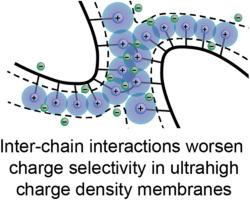Electrostatic limits on charge selectivity in ultrahigh charge density polymer membranes
IF 9
1区 工程技术
Q1 ENGINEERING, CHEMICAL
引用次数: 0
Abstract
Ion-exchange membranes (IEMs) with ultrahigh charge densities offer the promise of enhanced ion transport for electrochemical technologies, yet the fundamental limits of this membrane design strategy are not yet understood. In this work, we present a systematic study of bis(1-vinyl-3-imidazolium) cross-linked polymer membranes with fixed charge contents ranging from 6 to 9 mol/L[dry polymer], synthesized to isolate the effects of charge density at constant membrane water content. While ionic conductivity increases monotonically with increasing charge density, a sharp decline in charge selectivity is observed for the most densely charged membranes, defying conventional expectations. Structural, thermal, and mechanical analyses reveal a critical onset of network disruption and anomalous ion partitioning behavior in these densely charged membranes. With proper consideration of cross-linker geometry, these results are interpreted using Manning's counter-ion condensation theory, which suggests that closely packed charged cross-linkers amplify inter-chain electrostatic interactions and trigger excess counter-ion condensation. Our findings suggest that, beyond a threshold spacing between fixed charges, increased functionalization may harm rather than help charge selectivity of IEMs.

超高电荷密度聚合物膜中电荷选择性的静电限制
具有超高电荷密度的离子交换膜(IEMs)为电化学技术提供了增强离子传输的希望,但这种膜设计策略的基本限制尚不清楚。在这项工作中,我们系统地研究了双(1-乙烯基-3-咪唑)交联聚合物膜,其固定电荷含量范围为6至9 mol/L[干聚合物],合成以分离恒定膜含水量下电荷密度的影响。虽然离子电导率随着电荷密度的增加而单调增加,但在电荷密度最大的膜上观察到电荷选择性的急剧下降,这与传统的预期相反。结构、热学和力学分析揭示了这些密集带电膜中网络破坏和异常离子分配行为的关键开始。在适当考虑交联剂几何形状的情况下,这些结果可以用Manning的反离子凝聚理论来解释,该理论表明,紧密排列的带电交联剂放大了链间静电相互作用,并引发了过量的反离子凝聚。我们的研究结果表明,超过固定电荷之间的阈值间距,增加的功能化可能会损害而不是帮助iem的电荷选择性。
本文章由计算机程序翻译,如有差异,请以英文原文为准。
求助全文
约1分钟内获得全文
求助全文
来源期刊

Journal of Membrane Science
工程技术-高分子科学
CiteScore
17.10
自引率
17.90%
发文量
1031
审稿时长
2.5 months
期刊介绍:
The Journal of Membrane Science is a publication that focuses on membrane systems and is aimed at academic and industrial chemists, chemical engineers, materials scientists, and membranologists. It publishes original research and reviews on various aspects of membrane transport, membrane formation/structure, fouling, module/process design, and processes/applications. The journal primarily focuses on the structure, function, and performance of non-biological membranes but also includes papers that relate to biological membranes. The Journal of Membrane Science publishes Full Text Papers, State-of-the-Art Reviews, Letters to the Editor, and Perspectives.
 求助内容:
求助内容: 应助结果提醒方式:
应助结果提醒方式:


